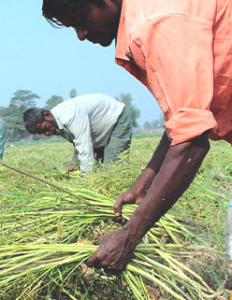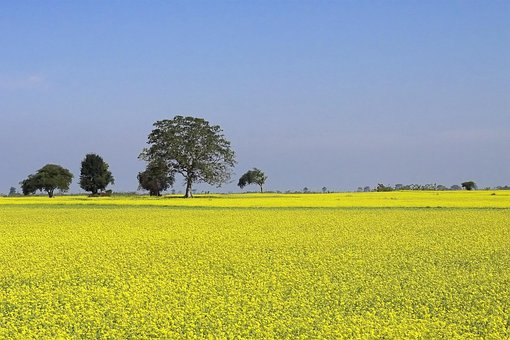Mustard Farming : India produces the fourth-largest amount of mustard oil in the world. In addition, mustard contributes about 28.6% to the production of oilseeds overall. India relies heavily on mustard as an oilseed crop. The mustard seed plant is also used as a green vegetable. It is also possible to use mustard seeds and their oil in cooking. Intercropping occurs when mustard is grown with wheat, barley, gram, potato, etc. There are several types of mustard crops in the family of “Cruciferae” that are commonly used in Indian cuisine.
Mustard farming is the most important agricultural product produced in India. A pickling solution is made up of oil and split mustard seeds. Oil from mustard is used in the kitchen for cooking. Indians also use mustard seed germination to prepare vegetables and curries. The oil cake can also be used to feed cattle. Because mustard cultivation is relatively inexpensive, you can quickly start mustard farming for less money. The following blog discusses the mustard plant and its cultivation process in detail.
Read More:A buffalo dairy farm Project Report: Costs and Profits
India’s regional mustard seed names
- Hindi – Rai, Banarasi rai, Kalee sarson
- Gujarati – Rai
- Kannada – Save
- Kashmiri – Sarisa, Issue
- Telugu – Avalu
- Tamil – Kadugo
- Malayalam – Kaduku
- Punjabi – Rai, Banarasi rai, Kalee sarson
India’s mustard-producing state
The cultivation of mustard has been carried out in Rajasthan since ancient times. Madhya Pradesh and Gujarat are also popular with mustard crops. Several southern Indian states, including Karnataka, Tamil Nadu, and Andhra Pradesh, also grow mustard crops. West Bengal, Assam, Bihar, and Orissa refer to Rabi as the yellow harvest season. Punjab, Haryana, Up and Himachal Pradesh grow this crop as a catch crop. A mustard farmer’s livelihood can be summed up as the heart of the Indian economy. Indian states that produce crops include these.
Growing Mustard Under Different Climate Conditions
A subtropical climate is ideal for mustard cultivation. A dry and cool climate is conducive to growing mustard seed. It is therefore commonly known as a Rabi crop during the mustard growing season. There is a critical temperature range between 10°C and 25°C for mustard seed trees. An area receiving 625 – 1000 mm of rainfall annually is ideal for growing mustard. It is necessary for mustard farms to have a clear sky and frost-free conditions because mustard does not tolerate freezing.
Agricultural Soil Requirements for Mustard Farming

Mustard can be grown on a variety of soil types, from light loamy soil to heavy loamy soil. The mustard crop grows best in medium-deep, well-drained soils. A soil pH range of 6.0 to 7.5 is ideal for mustard varieties. Prepare the soil properties by conducting a soil test, such as soil type, strength, and healthy levels. Suitable soils for Sarso farming include sandy and loamy sands. It is recommended to plant mustard plants about 45 cm apart and 20 cm apart.
Cultivation Methods for Mustard Crops

In the months of September and October, mustard is usually planted. Mustard crops should be drilled if they are pure, or broadcasted or drilled if they are mixed. Make sure the hybrid mustard seed is evenly spaced by mixing it with fine sand. The soil is sufficiently foggy when mustard seeds are planted. It is recommended that mustard seeds be planted in the soil at a depth of no less than 6 cm for better germination. We then described how mustard seeds grow in detail.
-
In September and October, toria crops are harvested.
-
All of October is a good time to sow African sarson and Taramira.
-
Complete sowing for Raya crop between mid-October and the end of November.
Read More: Future of Indian Agriculture and Emerging Trends in Agriculture
Mustard farming states include the following states that have the maximum amount of time to sow to ensure high yields.
| State | Mustard | |
| Seed Rate kg/ha | Spacing (cm) | |
| Haryana | 5.0 | 30 x 10-15 |
| Himachal Pradesh | 6.0 | 30 x 10-15 |
| Madhya Pradesh | 5.0-6.0 | 45 x 15 |
| Punjab | 3.5-4.0 | 30-45 x 10-15 |
| Rajasthan | 4.0-5.0 | 30 x 10 |
| Uttar Pradesh | 5.0-6.0 | 45 x 10 |
Mustard Seed Rate
It is imperative to thin seedlings three weeks after sowing and only keep healthy seedlings.
Below is a list of the recommended seed rates for mustard seeds so that you can obtain an optimal plant about mustard seeds for a higher yield.
-
The seeds per acre of rapeseed are 1.5 kg.
-
The rate for pure mustard crop seed could be between 4 and 6 kg per hectare.
-
It is recommended to seed mixed crops at a rate of 2 to 3 kg per hectare.
The preparation of land for mustard farming in India
As part of mustard farming field preparation, one to two ploughings and two harrowings are given. Further, two crosswise harrowings were performed after the Kharif crop to prepare the field for mustard seed cultivation in the second crop. In India, mustard crops are grown for a variety of reasons. See below for more information.
-
A fine seedbed is necessary for excellent crop germination.
-
After each ploughing, planking is done.
-
It is important to prepare a firm, moist, and uniform seedbed to help mustard seeds germinate evenly.
Agriculture Irrigation for Mustards
Seeds are irrigated before they are sown. It is generally necessary to apply irrigation to crops at intervals of three weeks after sowing in order to ensure good growth. It will help retain moisture in the soil if a good amount of organic manure is applied to it.
Weed Control Information About Mustard

A pure mustard crop is thinned after two weeks. Mixed crops received inter-cultivation from the main crop in the case of mustard. It is common for deep-rooted broad-leaved weeds to develop in Rapeseed and Mustard fields.
- Bathua – Chenopodium album
- Chatter mattari – Lathyms spp
- Kateli – Cirsium arvense
- Gajri – FumariapalVijlora
Khurpi is primarily used to hand-hoe weeds. During the early stages of weed growth, this method eliminates the weeds thoroughly. Furthermore, it reduces moisture loss by pulverizing and mulching the soil.
Control of weeds in the Toria crop by pre-planting with 400ml/200L of Trifluralin per acre. Within two days of sowing Raya crop, spray 400gm/200Ltr with pre-emergence spray.
The harvesting of mustard

Harvesting of mustard begins when the pods turn yellow and the seed becomes hard. During the growing season, mustard plants take between 110 and 160 days to produce. In order to prevent stock from being shattered, harvesting is done very early in the morning.
-
Crops are cut close to the ground with the aid of sickles.
-
Harvested crops were stacked for 7-10 days.
-
Once the threshing operation has been completed, the drying process should be completed.
| Type of R&M | Period of Maturity at Harvesting |
| Indian Mustard | 110-160 days |
| Yellow Sarson | 90-120 days |
A post-harvest mustard variety
Harvesting mustard plants is done by tying them into bundles, and keeping them in the sun for five to six days to dry the seeds, then storing them in gunny bags or bins. It is possible to thresh mustard plants by hitting them with a stick. Following that, grain and husk are separated by winnowing.
Mustard farming is rainfed
-
The practice of disc harrowing after every practical shower in monsoon conserves moisture. To prevent cloud formation and moisture loss, planking should immediately follow the cessation of rain.
-
The soil should be pulverized with a cultivator before sowing.
-
To prevent cloud formation and moisture loss, planking is essential on irrigated and non-irrigated lands
The types of mustard seeds grown in India

There are several best mustard varieties in India, as listed below
PBT 37
-
This mustard variety was developed in its early stages.
-
The process takes 91 days to complete.
-
The crop is suitable for Toria-wheat farming.
-
Dark brown seeds are large and robust.
-
Seeds contain 41.7% oil, providing 5.4 QTL/acre on average.
TL 15
-
This variety matures early.
-
The maturation process took 88 days.
-
The average yield is 4.5 QTL/acre.
TL 17
-
In 90 days, the crop is ready for harvest.
-
Multi-cropping is possible.
-
The average yield per acre is 5.2 QTL.
RLM 619
-
In irrigated and rainfed areas, it is recommended for farming.
-
You can pick it up in 143 days.
-
The seed contains 43% oil and is bold in appearance.
-
As a result, it is resistant to white rust, mildew, and downy mildew.
-
A yield of 8 QTLs per acre is expected.
PBR 91
-
The harvesting process takes 145 days.
-
The plant is resistant to blight, rust, and insect pests.
-
The average yield per acre is 8.1 quintals.
PBR 97
-
Rainfed cultivation is suitable for this variety.
-
A harvest is expected in 136 days.
-
There are 39.8% oils in the grains and they are medium bold.
-
The average yield per acre is 5.2 QTL.
PBR 210
-
Sow and irrigate timely.
-
In 150 days, it will be ready for harvest.
-
The average yield per acre is 6 QTL.
RLC 3
-
In 145 days, this tall variety will be ready for harvest.
-
An average yield of 7.3 QTL/acre is achieved.
-
There is 41.5% oil in it.
GSL 1
-
It takes 160 days from planting to harvest.
-
There is a short crop that does not lodge easily.
-
The average yield per acre is 6.7 QTL.
-
The oil content of seeds is 44.5%.
PGSH51
-
The crop will be ready in 162 days.
-
The average yield per acre is 7.9 QTL for tall and high yielding hybrids.
-
There is 44.5% oil content in seeds.
Hyola PAC 401
-
It matures in 150 days and is a medium height crop.
-
There is about 42% oil in the seeds, which are brownish-black in color.
-
The average yield is 6.74 QTL per acre.
GSC 6
-
Under irrigated conditions, it is recommended for timely sowing of crops.
-
Oil content is 39.1% in bold seeds.
-
The average yield is 6.07 QTL/acre.
RH 0749
-
This variety is suitable for cultivation in North Rajasthan, Delhi, Jammu, Punjab, and Haryana.
-
This variety produces more seeds per silique than most other varieties.
-
It takes between 146 and 148 days for the crop to be ready for harvest.
-
Oil percentage is 40% in bold seeds.
-
A yield of 10.5-11 QTL/acre can be expected.
T 59 (Varuna)
-
The product is suitable for all types of climates.
-
Ready to harvest in 145-150 days.
-
The oil content is about 39%.
-
The average yield per acre is 6-8 QTL.
You can do mustard farming in India using these best methods of cultivation. These methods help you earn a high income if you create a mustard farming business plan. The purpose of this blog is to provide you with information about how to plant mustard seeds and what a mustard plant is. You can learn more about mustard cultivation implements in India at Aarug Agro. Here you can find complete information about mustard farm machines, mustard production in India, and many other topics. The protected cultivation program is also available to you.


